Previewing Silicon Motion SM2260 NVMe Controller With 3D MLC NAND (512GB)
by Billy Tallis on February 17, 2017 9:00 AM ESTATTO
ATTO's Disk Benchmark is a quick and easy freeware tool to measure drive performance across various transfer sizes.
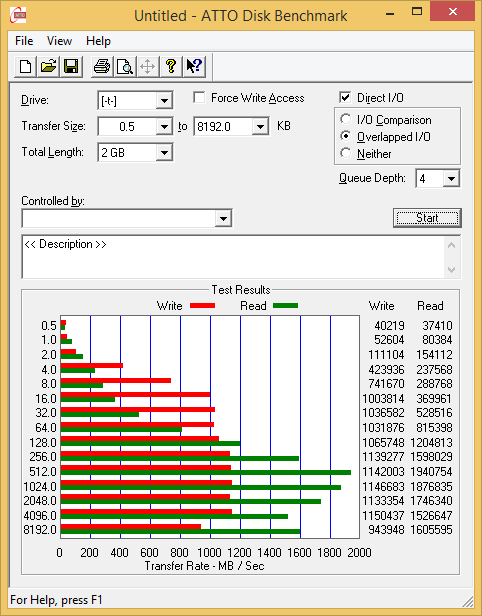 |
|||||||||
The SM2260 is close to its full write speed when the transfer size is 16kB, but full read speed takes much longer to attain and occurs at 512kB, after which thermal throttling slows things back down.
AS-SSD
AS-SSD is another quick and free benchmark tool. It uses incompressible data for all of its tests, making it an easy way to keep an eye on which drives are relying on transparent data compression. The short duration of the test makes it a decent indicator of peak drive performance.
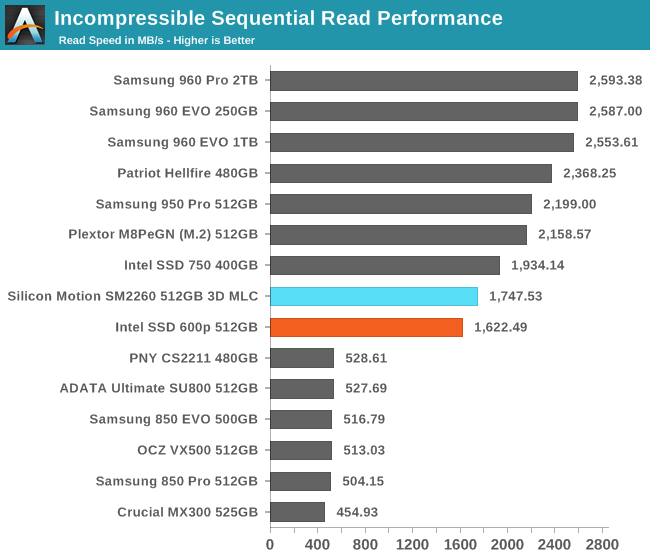
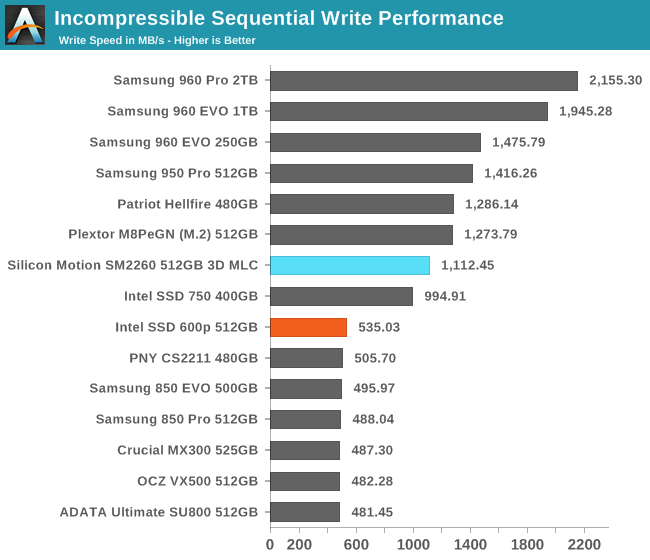
The peak sequential read speed of the SM2260 sample as measured by AS-SSD is slightly higher than the Intel SSD 600p instead of being tied as shown by our longer IOmeter test, but they both are still behind the rest of the NVMe crowd. For write speed, the SLC cache enables the SM2260 to beat the Intel SSD 750 in addition to the 600p, but it is also slightly slower than its more recent NVMe competition.
Idle Power Consumption
Since the ATSB tests based on real-world usage cut idle times short to 25ms, their power consumption scores paint an inaccurate picture of the relative suitability of drives for mobile use. During real-world client use, a solid state drive will spend far more time idle than actively processing commands. We report two measures of idle power consumption: active idle where the SSD is not in use but has not been put in to any low-power sleep state, and idle power consumption in the deepest sleep state supported by our testbed. For NVMe SSDs, the lowest drive power state is measured but PCIe Active State Power Management (ASPM) is not used due to limitations of this motherboard. For SATA SSDs, aggressive link power management is used to put the SATA link into slumber state. Many SSDs support a deeper DevSleep state, but this cannot be engaged using ordinary desktop platforms.
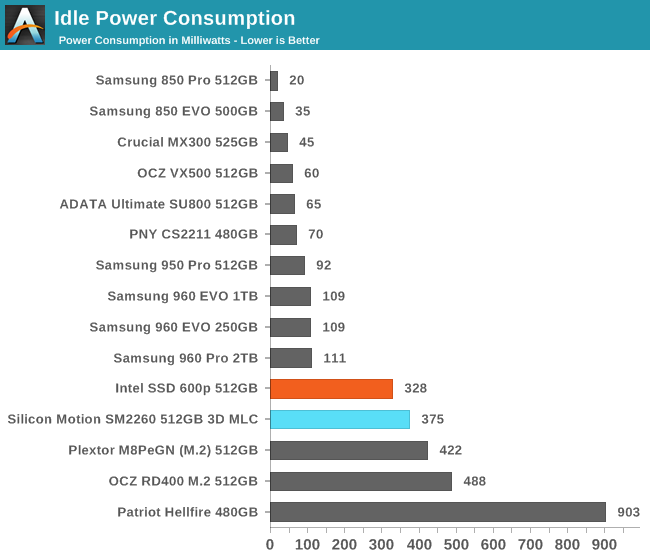
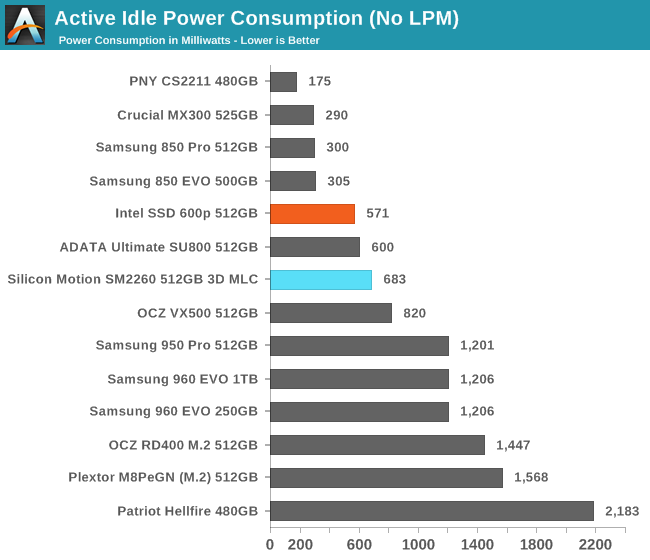
The SM2260 sample has slightly worse idle power consumption than the Intel SSD 600p, but it's ahead of the Plextor M8Pe and OCZ RD400, while the Phison E7-based Patriot Hellfire is in a distant last place among M.2 PCIe SSDs. Samsung continues to deliver far better idle power that is close to what we typically see for SATA SSDs.
For active idle power without making use of any explicit power saving modes, the SM2260 does better than any PCIe SSD and better than at least one SATA SSD, but the SM2260 sample is still using a bit more power than the Intel SSD 600p.










27 Comments
View All Comments
BrokenCrayons - Friday, February 17, 2017 - link
It seems like power consumption and consistency are both problems. Consistency can probably be addressed through tuning and optimization of firmware, but power consumption is probably something that can't be fine-tuned away. NVMe drives aren't as power friendly as SATA, but the inefficiencies of some recently reviewed SSDs here on Ananatech certainly seems to throw a spotlight on the problem. Between that and thermal throttling, the NVMe storage picture isn't very rosy just yet.KAlmquist - Friday, February 17, 2017 - link
Even with 25% overprovisioning, I see a 1 second interval at the 3350 mark where the IOP's fall to zero. Fortunately, the performance consistency of this SSD seems more in line with its competitors on the trace-based benchmarks (The Destroyer, etc.).The sequential read performance at queue depth 1 is lower than that of budget SATA SSD's like the MX300. At higher queue depths, the sequential reads are faster than anything a SATA SSD can manage, but queue depths of 1 are not uncommon in a desktop environment.
vladx - Saturday, February 18, 2017 - link
Now we can see why Micron cancelled its' NVMe SSD using the SM2260, it's simply not competive.Drumsticks - Saturday, February 18, 2017 - link
So what's a good roundup conclusion on the current state of NVMe drives? If we want to pick one up this year, where does the performance go from "bad for NVMe" to "not Samsung but still pretty good!"? Plextor?vladx - Saturday, February 18, 2017 - link
Indeed Plextor M8Pe seems to be the best buy option at the moment in the NVMe space.Drumsticks - Saturday, February 18, 2017 - link
That's what I was thinking. $220/$240 for the 500GB model right now. So much more than it used to be. Do we have any news on whether anything constraining nand supply will be alleviating any time soon?vladx - Saturday, February 18, 2017 - link
The supply problems most likely will be gone after Chinese companies will flood this market in 2018. But it could happen sooner than that depending on how fast will Toshiba/Western Digital will be rolling up their own 3D NAND supply.Chaser - Saturday, February 18, 2017 - link
"and the Plextor M8Pe is very slightly faster."AbRASiON - Sunday, February 19, 2017 - link
If this is CHEAPER than an MX300 it's an incredibly good bargain. The MX300's are really really well priced. I'd consider it if it's dead, dead cheap.The 960 Evo / Pro is a joke, sure it's fast but in real world usage, it's ridiculously expensive.
Make the 1TB version of this for $250 US or less and I'm very much in. (I doubt it will though)
StrangerGuy - Sunday, February 19, 2017 - link
I know right, Techreport tested the 960 Evo/Pro are both so close to yesteryears SATA3 SSDs in real-world load times that they are easily within the margin of error. I don't care about how NVMe is able to reach uber fast raw speeds that has zero use to me or to 99% of the people out there, but a hypothetical SSD with half the raw transfer speed of current SATA3 SSDs for 2x the capacity per dollar? That's a real bargain.